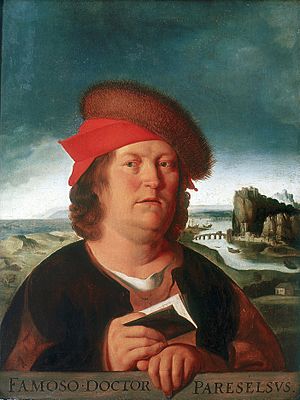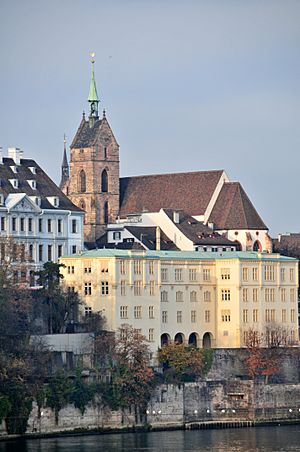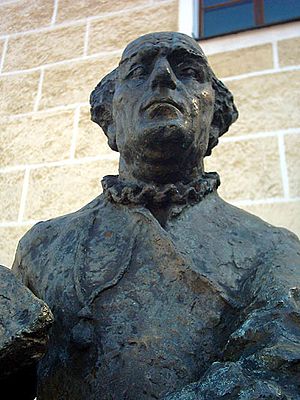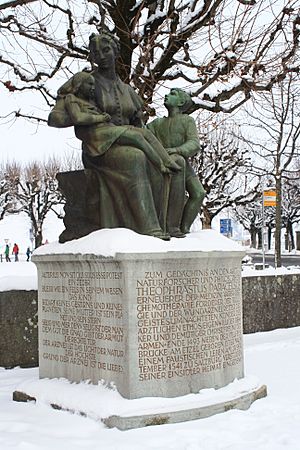Paracelsus facts for kids
Quick facts for kids
Paracelsus
|
|
|---|---|

Paracelsus
|
|
| Born |
Theophrastus von Hohenheim
1493 or 1494 Egg, near Einsiedeln, Schwyz (present-day Switzerland)
|
| Died | 24 September 1541 (aged 47) Salzburg, Archbishopric of Salzburg (present-day Austria)
|
| Other names | Aureolus Philippus Theophrastus, Doctor Paracelsus |
| Alma mater | University of Ferrara |
| Era | Renaissance philosophy |
| Region | Western philosophy |
| School | Renaissance humanism |
|
Notable ideas
|
Toxicology "The dose makes the poison" |
|
Influences
|
|
|
Influenced
Franciscus Sylvius, Sir Thomas Browne, Adam Haslmayr, Gabriel François Venel (disputed), Jane Bennett, Giorgio Agamben |
|
Paracelsus (11 November or 17 December 1493 in Einsiedeln, Switzerland – 24 September 1541 in Salzburg, Austria) was a Swiss alchemist, physician, astrologer, and general occultist. The name "Paracelsus" was a nickname: it means "equal to or greater than Celsus", and refers to his medical skill.
Paracelsus was responsible for the creation of laudanum, an alcoholic herbal preparation. It was in common use up to the 19th century. Like most of the alchemists, he was a notable botanist. He wrote various books, his major work being (title translated as: On the miners' sickness and other diseases of miners). In it, he presented his observation of diseases of miners and the effects of various minerals and metals in the human organism. He also wrote a book on the human body which contradicted Galen's ideas.
Paracelsus emphasized the value of observation in combination with received wisdom. He is credited as the "father of toxicology". Paracelsus also had a substantial influence as a prophet. Paracelsianism is the early modern medical movement inspired by the study of his works.
Contents
Early life and education
Paracelsus was born in Egg an der Sihl, a village close to the Etzel Pass in Einsiedeln, Schwyz. His father Wilhelm (d. 1534) was a chemist and physician.
Paracelsus' mother was probably a native of the Einsiedeln region and a bondswoman of Einsiedeln Abbey.
Paracelsus' mother probably died in 1502, after which Paracelsus's father moved to Villach, Carinthia, where he worked as a physician. Paracelsus was educated by his father in botany, medicine, mineralogy, mining, and natural philosophy. It is likely that Paracelsus received his early education mainly from his father. At the age of 16, he started studying medicine at the University of Basel, later moving to Vienna. He gained his medical doctorate from the University of Ferrara in 1515 or 1516.
Early career
"Paracelsus sought a universal knowledge" that was not found in books or faculties. Thus, between 1517 and 1524, he embarked on a series of extensive travels around Europe. His wanderings led him from Italy, France, to Spain, Portugal, to England, Germany, Scandinavia, Poland, Russia, Hungary, Croatia, to Rhodes, Constantinople, and possibly even Egypt. During this period of travel, Paracelsus enlisted as an army surgeon and was involved in the wars waged by Venice, Holland, Denmark, and the Tartars. Then Paracelsus returned home from his travels in 1524.
In 1524, "[a]fter visiting his father at Villach and finding no local opportunity to practice, he settled in Salzburg" as a physician, and remained there until 1527.
Basel (1526–1528)

In 1527, Paracelsus was a licensed physician in Basel with the privilege of lecturing at the University of Basel. At that time, Basel was a centre of Renaissance humanism, and Paracelsus here came into contact with Erasmus of Rotterdam, Wolfgang Lachner, and Johannes Oekolampad.
Paracelsus' lectures at Basel university unusually were given in German, not Latin. He stated that he wanted his lectures to be available to everyone. He published harsh criticism of the Basel physicians and apothecaries, creating political turmoil to the point of his life being threatened. In a display of his contempt for conventional medicine, Paracelsus publicly burned editions of the works of Galen and Avicenna. On 23 June 1527, he burnt a copy of Avicenna's Canon of Medicine, an enormous tome that was a pillar of academic study, in market square.
During his time as a professor at the University of Basel, he invited barber-surgeons, alchemists, apothecaries, and others lacking academic background to serve as examples of his belief that only those who practised an art knew it: "The patients are your textbook, the sickbed is your study." Paracelsus was compared with Martin Luther because of his openly defiant acts against the existing authorities in medicine. In February 1528, Paracelsus left Basel for Alsace.
Later career

In Alsace, Paracelsus didn't stay long. He had to move to Nuremberg in 1529. His reputation went before him, and the medical professionals excluded him from practising. When his further stay in Nuremberg had become impossible, he retired to Beratzhausen.
The name Paracelsus is first attested around this time. It was used as a pseudonym for the publication of a Practica of political-astrological character in Nuremberg. Some scholars suppose that the name was intended for use as the author of non-medical works, while his real name Theophrastus von Hohenheim was used for medical publications.
In Beratzhausen, Paracelsus prepared Paragranum, his main work on medical philosophy, completed 1530. Moving on to St. Gall, he then completed his Opus Paramirum in 1531. From St. Gall, he moved on to the land of Appenzell, where he was active as lay preacher and healer among the peasantry. In the same year, he visited the mines in Schwaz and Hall in Tyrol, working on his book on miners' diseases. He moved on to Innsbruck, where he was once again barred from practising. He passed Sterzing in 1534, moving on to Meran, Veltlin, and St. Moritz, which he praised for its healing springs.
His Astronomia magna (also known as Philosophia sagax) was completed in 1537 but not published until 1571. It is a treatise on hermeticism, astrology, divination, theology, and demonology that laid the basis of Paracelsus's later fame as a "prophet". His motto Alterius non sit qui suus esse potest ("Let no man belong to another who can belong to himself") is inscribed on a 1538 portrait by Augustin Hirschvogel.
Death and legacy
In 1541, Paracelsus moved to Salzburg, probably on the invitation of Ernest of Bavaria, where he died on 24 September. He was buried in St. Sebastian's cemetery in Salzburg. His remains were relocated inside St. Sebastian's church in 1752.
After his death, the movement of Paracelsianism was seized upon by many wishing to subvert the traditional Galenic physics, and his therapies became more widely known and used. His manuscripts have been lost, but many of his works which remained unpublished during his lifetime were edited by Johannes Huser of Basel during 1589 to 1591. His works were frequently reprinted and widely read during the late 16th to early 17th centuries, and although his "occult" reputation remained controversial, his medical contributions were universally recognized: a 1618 pharmacopeia by the Royal College of Physicians in London included "Paracelsian" remedies.
Philosophy
Astrology was a very important part of Paracelsus's medicine and he was a practising astrologer, as were many of the university-trained physicians working at that time in Europe. Paracelsus devoted several sections in his writings to the construction of astrological talismans for curing disease. Although he did accept the concept of the four elements—water, air, fire, and earth; he saw them as a foundation for other properties on which to build.
Paracelsus often uses an egg to help describe the elements. In his early model, he claimed that air surrounded the world like an egg shell. The egg white below the shell is like fire because it has a type of chaos to it that allows it to hold up earth and water. The earth and water make up a globe which, in his egg analogy, is the yolk.
Paracelsus's approach to science was heavily influenced by his religious beliefs. He believed that science and religion were inseparable, and scientific discoveries were direct messages from God. Thus, he believed it was mankind's divine duty to uncover and understand all of His message.
Contributions to medicine

Chemistry
Paracelsus was one of the first medical professors to recognize that physicians required a solid academic knowledge in the natural sciences, especially chemistry. Paracelsus pioneered the use of chemicals and minerals in medicine.
He was probably the first to give the element zinc (zincum) its modern name, in about 1526, likely based on the sharp pointed appearance of its crystals after smelting (zinke translating to "pointed" in German). Paracelsus invented chemical therapy, chemical urinalysis, and suggested a biochemical theory of digestion. Paracelsus used chemistry and chemical analogies in his teachings to medical students and to the medical establishment.
Paracelsus in the beginning of the sixteenth century had unknowingly observed hydrogen as he noted that in reaction when acids attack metals, gas was a by-product. Later, Théodore de Mayerne repeated Paracelsus's experiment in 1650 and found that the gas was flammable. However, neither Paracelsus nor de Mayerne proposed that hydrogen could be a new element.
Hermeticism
His hermetic beliefs were that sickness and health in the body relied upon the harmony of humans (microcosm) and nature (macrocosm). He took a different approach from those before him, using this analogy not in the manner of soul-purification but in the manner that humans must have certain balances of minerals in their bodies, and that certain illnesses of the body had chemical remedies that could cure them. As a result of this hermetical idea of harmony, the universe's macrocosm was represented in every person as a microcosm. An example of this correspondence is the doctrine of signatures used to identify curative powers of plants. If a plant looked like a part of the body, then this signified its ability to cure this given anatomy.
Paracelsus believed that true anatomy could only be understood once the nourishment for each part of the body was discovered. He believed that one must therefore know the influence of the stars on these particular body parts. Diseases were caused by poisons brought from the stars. However, 'poisons' were not necessarily something negative, in part because related substances interacted, but also because only the dose determined if a substance was poisonous. Paracelsus claimed in contrast to Galen, that like cures like. If a star or poison caused a disease, then it must be countered by another star or poison. Because everything in the universe was interrelated, beneficial medical substances could be found in herbs, minerals, and various chemical combinations thereof.
Discoveries and treatments
Hippocrates put forward the theory that illness was caused by an imbalance of the four humours: blood, phlegm, black bile and yellow bile. These ideas were further developed by Galen into an extremely influential and highly persistent set of medical beliefs that were to last until the mid-1850s. Contrarily, Paracelsus believed in three humors: salt (representing stability), sulphur (representing combustibility), and mercury (representing liquidity); he defined disease as a separation of one humor from the other two. He believed that body organs functioned alchemically, that is, they separated pure from impure. The dominant medical treatments in Paracelsus's time were specific diets to help in the "cleansing of the putrefied juices" combined with purging and bloodletting to restore the balance of the four humours. Paracelsus supplemented and challenged this view with his beliefs that illness was the result of the body being attacked by outside agents. He objected to excessive bloodletting, saying that the process disturbed the harmony of the system, and that blood could not be purified by lessening its quantity. Paracelsus believed that fasting helped enable the body to heal itself. 'Fasting is the greatest remedy, the physician within.'
Paracelsus gave birth to clinical diagnosis and the administration of highly specific medicines. The germ theory was anticipated by him as he proposed that diseases were entities in themselves, rather than states of being. Paracelsus prescribed black hellebore to alleviate certain forms of arteriosclerosis. Lastly, he recommended the use of iron for "poor blood" and is credited with the creation of the terms "chemistry," "gas," and "alcohol".
Toxicology
Paracelsus extended his interest in chemistry and biology to what is now considered toxicology. He believed that diseases locate in a specific organ. He also said that there is a specific site in the body where a chemical will exert its greatest effect. Paracelsus encouraged using experimental animals to study both beneficial and toxic chemical effects. He was one of the first scientists to introduce chemistry to medicine. He advocated the use of inorganic salts, minerals, and metals for medicinal purposes. He held the belief that organs in the body operated on the basis of separating pure substances from impure ones. Humans must eat to survive and they eat both pure and impure things. It is the function of organs to separate the impure from the pure.
Psychosomatism
Paracelsus is one of the first physicians to suggest that mental well-being and a moral conscience had a direct effect on physical health. He proposed that the state of a person's psyche could cure and cause disease. Theoretically, a person could maintain good health through sheer will. He also stated that whether or not a person could succeed in their craft depended on their character. For example, if a physician had shrewd and immoral intentions then they would eventually fail in their career because evil could not lead to success. When it came to mental illness, Paracelsus stressed the importance of sleep and sedation as he believed sedation (with sulphur preparations) could catalyse healing and cure mental illness.
Selected English translations
- The Hermetic and Alchemical Writings of Paracelsus, Two Volumes, translated by Arthur Edward Waite, London, 1894.
- Paracelsus: Essential Readings. Selected and translated by Nicholas Goodrick-Clarke. Berkeley, CA: North Atlantic Books, 1999.
- Paracelsus: His Life and Doctrines. Franz Hartmann, New York: Theosophical Publishing Co., 1918
- Paracelsus (Theophrastus Bombastus von Hohenheim, 1494–1541). Essential Theoretical Writings. Edited and translated with a Commentary and Introduction by Andrew Weeks. Leiden/Boston: Brill, 2008, ISBN: 978-90-04-15756-9.
- Paracelsus: Selected Writings ed. with an introduction by Jolande Jacobi, trans. Norbert Guterman, New York: Pantheon, 1951 reprinted Princeton 1988
Images for kids
See also
 In Spanish: Paracelso para niños
In Spanish: Paracelso para niños



